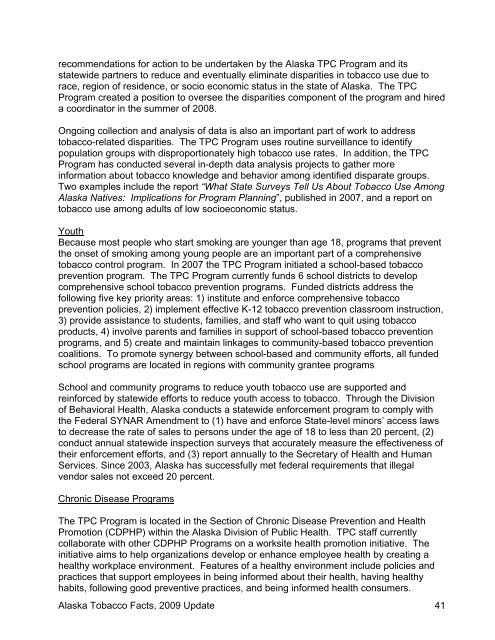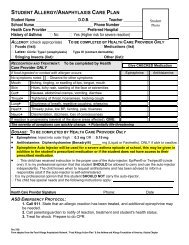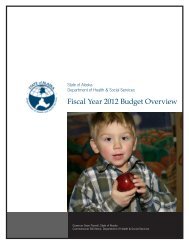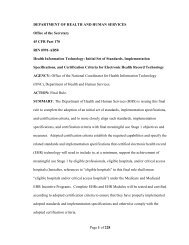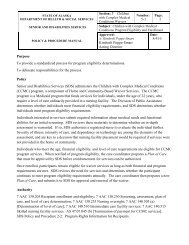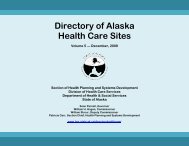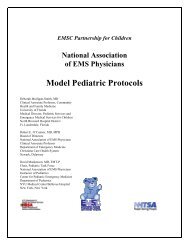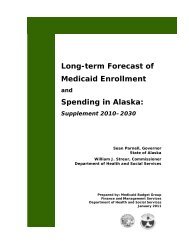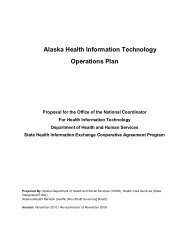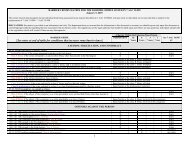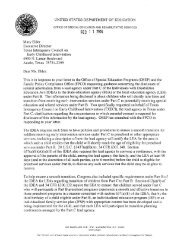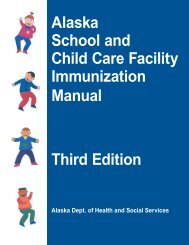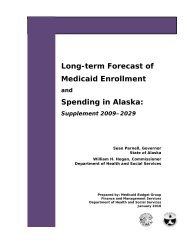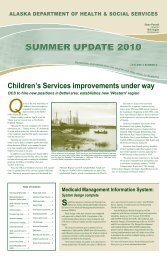AK Tobacco Facts - Alaska Department of Health and Social ...
AK Tobacco Facts - Alaska Department of Health and Social ...
AK Tobacco Facts - Alaska Department of Health and Social ...
You also want an ePaper? Increase the reach of your titles
YUMPU automatically turns print PDFs into web optimized ePapers that Google loves.
ecommendations for action to be undertaken by the <strong>Alaska</strong> TPC Program <strong>and</strong> its<br />
statewide partners to reduce <strong>and</strong> eventually eliminate disparities in tobacco use due to<br />
race, region <strong>of</strong> residence, or socio economic status in the state <strong>of</strong> <strong>Alaska</strong>. The TPC<br />
Program created a position to oversee the disparities component <strong>of</strong> the program <strong>and</strong> hired<br />
a coordinator in the summer <strong>of</strong> 2008.<br />
Ongoing collection <strong>and</strong> analysis <strong>of</strong> data is also an important part <strong>of</strong> work to address<br />
tobacco-related disparities. The TPC Program uses routine surveillance to identify<br />
population groups with disproportionately high tobacco use rates. In addition, the TPC<br />
Program has conducted several in-depth data analysis projects to gather more<br />
information about tobacco knowledge <strong>and</strong> behavior among identified disparate groups.<br />
Two examples include the report “What State Surveys Tell Us About <strong>Tobacco</strong> Use Among<br />
<strong>Alaska</strong> Natives: Implications for Program Planning”, published in 2007, <strong>and</strong> a report on<br />
tobacco use among adults <strong>of</strong> low socioeconomic status.<br />
Youth<br />
Because most people who start smoking are younger than age 18, programs that prevent<br />
the onset <strong>of</strong> smoking among young people are an important part <strong>of</strong> a comprehensive<br />
tobacco control program. In 2007 the TPC Program initiated a school-based tobacco<br />
prevention program. The TPC Program currently funds 6 school districts to develop<br />
comprehensive school tobacco prevention programs. Funded districts address the<br />
following five key priority areas: 1) institute <strong>and</strong> enforce comprehensive tobacco<br />
prevention policies, 2) implement effective K-12 tobacco prevention classroom instruction,<br />
3) provide assistance to students, families, <strong>and</strong> staff who want to quit using tobacco<br />
products, 4) involve parents <strong>and</strong> families in support <strong>of</strong> school-based tobacco prevention<br />
programs, <strong>and</strong> 5) create <strong>and</strong> maintain linkages to community-based tobacco prevention<br />
coalitions. To promote synergy between school-based <strong>and</strong> community efforts, all funded<br />
school programs are located in regions with community grantee programs<br />
School <strong>and</strong> community programs to reduce youth tobacco use are supported <strong>and</strong><br />
reinforced by statewide efforts to reduce youth access to tobacco. Through the Division<br />
<strong>of</strong> Behavioral <strong>Health</strong>, <strong>Alaska</strong> conducts a statewide enforcement program to comply with<br />
the Federal SYNAR Amendment to (1) have <strong>and</strong> enforce State-level minors’ access laws<br />
to decrease the rate <strong>of</strong> sales to persons under the age <strong>of</strong> 18 to less than 20 percent, (2)<br />
conduct annual statewide inspection surveys that accurately measure the effectiveness <strong>of</strong><br />
their enforcement efforts, <strong>and</strong> (3) report annually to the Secretary <strong>of</strong> <strong>Health</strong> <strong>and</strong> Human<br />
Services. Since 2003, <strong>Alaska</strong> has successfully met federal requirements that illegal<br />
vendor sales not exceed 20 percent.<br />
Chronic Disease Programs<br />
The TPC Program is located in the Section <strong>of</strong> Chronic Disease Prevention <strong>and</strong> <strong>Health</strong><br />
Promotion (CDPHP) within the <strong>Alaska</strong> Division <strong>of</strong> Public <strong>Health</strong>. TPC staff currently<br />
collaborate with other CDPHP Programs on a worksite health promotion initiative. The<br />
initiative aims to help organizations develop or enhance employee health by creating a<br />
healthy workplace environment. Features <strong>of</strong> a healthy environment include policies <strong>and</strong><br />
practices that support employees in being informed about their health, having healthy<br />
habits, following good preventive practices, <strong>and</strong> being informed health consumers.<br />
<strong>Alaska</strong> <strong>Tobacco</strong> <strong>Facts</strong>, 2009 Update 41


